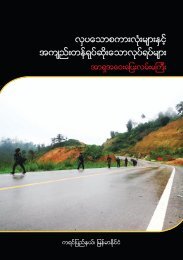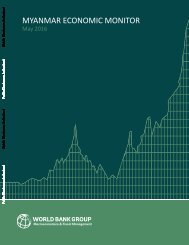Myanmar
1WZPRL1Jj
1WZPRL1Jj
- No tags were found...
Create successful ePaper yourself
Turn your PDF publications into a flip-book with our unique Google optimized e-Paper software.
MYANMAR BUSINESS SURVEY: DATA ANALYSIS AND POLICY IMPLICATIONS<br />
sampling frame were available to the survey team.<br />
Consequently, convenience, snow-balling and seminar<br />
sampling methods, 7 all of which are non-probability<br />
sampling methods, were used to minimize the cost of<br />
the survey while maximizing the number of responses<br />
and the accuracy of the survey. 8 The survey consisted<br />
of pre-appointed onsite interviews by trained personnel<br />
to enhance the quality of the data collection while<br />
increasing the response rate. Interview guides were<br />
prepared for the interviewers and updated from time<br />
to time as data collection progressed.<br />
A large sample was targeted (i.e., at least 2 500 firms)<br />
in order to achieve a reasonable representation of the<br />
business sector in <strong>Myanmar</strong>. All 14 States/Regions and<br />
Nay Pyi Taw Union Territory, the capital of <strong>Myanmar</strong>,<br />
were covered by the survey. Specifically, the survey<br />
was administered in the capital of each State/Region. 9<br />
Events such as press conferences and meetings<br />
with business associations were also frequently held<br />
to inform the business communities in <strong>Myanmar</strong> of<br />
the business survey in advance and to seek their<br />
cooperation. The survey team also contacted local<br />
chambers of commerce and industry to inform them<br />
of the survey and to request collaboration.<br />
One potential drawback of this survey is that the<br />
sample is not strictly representative in a statistical sense,<br />
although it covers a very large number of firms in all<br />
geographic locations. As mentioned above, the unique<br />
circumstances of <strong>Myanmar</strong> have made information on<br />
businesses a scarce commodity. Information on the<br />
total business population and its district characteristics<br />
does not exist, making conventional sampling methods<br />
unviable. In fact <strong>Myanmar</strong> has only recently completed<br />
its first census in more than 30 years. Furthermore,<br />
several key sectors and enterprises are still controlled<br />
by the public sector and its associates which make<br />
access challenging for international surveys such as the<br />
present survey. As a result, even the best sampling<br />
methods would likely introduce unintentional bias.<br />
Although the sample may not, strictly speaking, be<br />
representative, it still provides the most comprehensive<br />
view currently available of the situation on the ground<br />
for many firms in <strong>Myanmar</strong>.<br />
Survey team<br />
The 120-member survey team comprised members<br />
from UMFCCI as well as advisors from ESCAP and<br />
OECD. In total, it included 15 task force executives,<br />
two international advisers, one executive director, one<br />
project manager, two survey team assistants, five area<br />
managers, 94 volunteers. The detailed survey team<br />
structure is shown in figure 2.1.<br />
One three-day training workshop was conducted for<br />
the project manager and the area managers by the<br />
ESCAP adviser at UMFCCI in early December 2013.<br />
Then more than 100 volunteers, or interviewers, were<br />
recruited by project and area managers in different<br />
cities/towns across <strong>Myanmar</strong> and given intensive<br />
training. In late December 2013 and January 2014,<br />
a total of 16 training sessions were conducted by<br />
the managers in different cities and towns for the<br />
interviewers.<br />
Data collection<br />
Data collection was started in the first week of January<br />
2014 when the printed questionnaire (in both Burmese<br />
and English) was distributed to the area managers,<br />
who then assigned teams of trained volunteers to<br />
conduct interviews in their designated areas or cities.<br />
Even though there were more than 110 volunteers in<br />
January 2014, some of them were dismissed due to<br />
the lack of competency in conducting interviews. The<br />
project had employed 94 volunteers or interviewers,<br />
including some team leaders, by the end of data<br />
collection in the second week of March 2014. Either<br />
a Burmese or an English questionnaire was used for<br />
the interview, according to the interviewee’s preference;<br />
however, the English version was typically used for<br />
foreigners or foreign enterprises. If requested, the<br />
interactive form of the questionnaire was distributed<br />
by hand or email to informants, usually larger firms<br />
or foreigners, and collected later.<br />
To ensure the effectiveness and efficiency of the data<br />
collection, a two-day training workshop on survey<br />
methodology was organized in Bangkok at the end<br />
of January 2014 by ESCAP for all the survey team<br />
managers. During the workshop, difficulties and<br />
challenges faced by the survey team in the field were<br />
14







